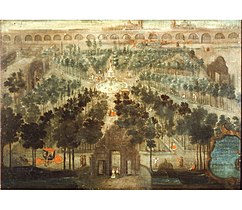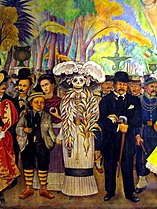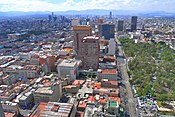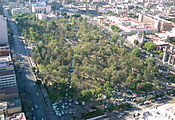| Alameda Central | |
|---|---|
 Aerial shot of Alameda Central to the north-west Aerial shot of Alameda Central to the north-west | |
 | |
| Type | Urban park |
| Location | Cuauhtémoc, Mexico City, Mexico |
| Coordinates | 19°26′08″N 99°08′38″W / 19.43556°N 99.14389°W / 19.43556; -99.14389 |
Alameda Central is a public urban park in downtown Mexico City. Established in 1592, Alameda Central is the oldest public park in the Americas. Located in Delegación Cuauhtémoc between Juárez Avenue and Hidalgo Avenue, the park is adjacent to the Palacio de Bellas Artes and can be accessed by Metro Bellas Artes.
Description
The Alameda Central park is a green garden with paved paths and decorative fountains and statues, and is frequently the center of civic events. The area used to be an Aztec marketplace. On 11 January 1592, Viceroy Luis de Velasco II ordered the creation of a public green space for the city's residents. The name comes from the Spanish word álamo, which means poplar tree, that were planted here. This park was part of the viceroy's plan to develop what was, at that time, the western edge of the city. It has become a symbol of a traditional Mexican park and many other parks in the country take on the name "Alameda" as well.
Public art

Fountains and statues in the park include:
- Beethoven Monument
- Benito Juárez Hemicycle
- Désespoire
- Fountain of Mercury
- Fountain of Neptune
- Fountain of Venus
- Fountain of Virgin (central fountain)
- Gladiador frigio
- Gladiador romano
- La Primavera
- Las Danaides
- Malgré Tout
- Statue of Alexander von Humboldt
History
The original park was less than half the size of the current one, reaching only from where the Palacio de Bellas Artes is now to the location of the Hemiciclo de Juárez. What is now the western section of the park originally was a plain plaza built during the Inquisition in Mexico and known as El Quemadero (The Burning Place). Here witches and others convicted by the Inquisitors were publicly burned at the stake. By the 1760s, the Inquisition had nearly come to an end, and in 1770, viceroy Marqués de Croix had this plaza torn up to expand the park. The park was expanded again in 1791, when the Count of Revillagigedo built a wooden fence around the park to make it exclusive for the nobility. However, when Mexican Independence was won in 1821, the Alameda was the center of popular celebrations. In 1846, when President Santa Anna rode triumphantly into Mexico City, he ordered the fountains in the park be filled with alcohol.
The five classical fountains are of French design and inspired by Greco-Roman mythology. More statues were added to the park in the 19th century. Gas lamps were installed in 1868, which were replaced by electrical lighting 1892. By the end of the 19th century, the park had become popular with all social classes in Mexico. Much of the current layout of the park, with its starburst pattern of paths around fountains and the central kiosk dates from the late 19th and early 20th centuries.
By the late 19th century, the park included a bandstand and gas (now electric) lamps. On the south side of the park, facing toward the street is the Hemiciclo a Juárez, which is a large white semi-circular monument to Benito Juárez, one of Mexico's most beloved presidents.
The park's statues include Désespoire and Malgré Tout, by Jesús Fructuoso Contreras, and a monument donated by the German community which is dedicated to Beethoven in commemoration of the centenary of his 9th Symphony.
In 2012, the park went through a rehabilitation which began in May and was completed in December. The renewal included replacing the damaged pavement with marble, the improvement of the vegetation (including the planting of new trees), new light posts, and improvement of existing park features (e.g. benches and the fountains). As part of the rehabilitation, the once ubiquitous street vendors are no longer allowed to operate within the park.
-
 Views of the Alameda (today called Alameda Central) and the Palace of the Viceroys of Mexico, anonymous painter, Mexico City, ca. 1676. Museum of the Americas, Madrid.
Views of the Alameda (today called Alameda Central) and the Palace of the Viceroys of Mexico, anonymous painter, Mexico City, ca. 1676. Museum of the Americas, Madrid.
-
 La Alameda de México, anonymous painter, 18th century, Mexico City. Museum of the Americas, Madrid.
La Alameda de México, anonymous painter, 18th century, Mexico City. Museum of the Americas, Madrid.
-
 Plan of the Alameda, ca. 18th century
Plan of the Alameda, ca. 18th century
-
 The Alameda Central in 1848 by Nathaniel Currier. Museo Amparo, Puebla City.
The Alameda Central in 1848 by Nathaniel Currier. Museo Amparo, Puebla City.
-
 The Alameda of Mexico, taken from a balloon, Casimiro Castro, ca. 1869. New York Public Library.
The Alameda of Mexico, taken from a balloon, Casimiro Castro, ca. 1869. New York Public Library.
-
 Detail of Diego Rivera's Sueño de una Tarde Dominical en la Alameda Central, 1947
Detail of Diego Rivera's Sueño de una Tarde Dominical en la Alameda Central, 1947
-
 1944 aerial photo of the Alameda Central
1944 aerial photo of the Alameda Central
During the COVID-19 pandemic, the Mexico City authorities closed the Alameda Central and other public spaces in the historic centre to prevent crowds from gatherings, in an effort to decrease COVID-19 transmissions. The closure of the Alameda and other historic public spaces affected some vulnerable populations, including homeless people, beggars, street vendors, street performers, and male sex workers, to the extent that they resisted leaving or found ways to return to public space, revealing different forms of long-lasting social inequalities and struggles for the use of urban space.
Gallery
-
 Aerial view and adjacent buildings
Aerial view and adjacent buildings
-
 Benito Juárez Hemicycle, 1910
Benito Juárez Hemicycle, 1910
-
Beethoven Monument, 1921
-
 View of the park before the 2012 rehabilitation. Note the many street vendors.
View of the park before the 2012 rehabilitation. Note the many street vendors.
-
 One of the various fountains within the park
One of the various fountains within the park
-
 One of the paths through the park
One of the paths through the park
-
 Gladiador frigio by José María Labastida (bronze copy)
Gladiador frigio by José María Labastida (bronze copy)
See also
References
- Meade, Julie (2016). Moon Mexico City. Avalon Publishing. ISBN 9781631214097.
Just west of Bellas Artes, the Alameda Central is the largest green space in the center of the city and the oldest public park in the Americas.
- "Three Kings Day in Mexico, a holiday in flux". LA Times Blogs - La Plaza. 6 January 2011.
Consider the scene this week at the Alameda Central, the downtown Mexico City park historians describe as the oldest planned urban green space in the Americas.
- "Cumplirá la Alameda Central 413 años". archivo.eluniversal.com.mx (in Spanish). El Universal. 10 January 2005.
- ^ Noble, John (2000). Lonely Planet Mexico City. Oakland CA: Lonely Planet. ISBN 1-86450-087-5.
- ^ Humphrey, Chris (2005). Moon Handbooks Mexico City. Emeryville, CA: Avalon Travel Publishing. pp. 46–47. ISBN 1-56691-612-7.
- Pohlsander, Hans A. (2010). German Monuments in the Americas: Bonds Across the Atlantic. Peter Lang. p. 133. ISBN 978-3034301381.
- "Rehabilitación de la Alameda Central y su Entorno". obrasenmiciudad.df.gob.mx. Archived from the original on October 6, 2014. Retrieved October 3, 2014.
- "Ambulantes no volverán a la Alameda Central: Ebrard". Azteca Noticias. Archived from the original on 4 March 2016. Retrieved 29 September 2015.
- "Biombo del Palacio de los Virreyes de México". Ministry of Culture and Sport (Spain) (Museum of the Americas website). Spain.
- María Luisa Sabau García (1994). México en el mundo de las colecciones de arte: Nueva España 2. Vol. 4. p. 15. ISBN 9686963367.
- "NATHANIEL CURRIER. La Alameda de México, 1848". Amparo Museum website.
- "Items: The Alameda of Mexico, taken from a balloon". The New York Public Library Digital Collections.
- Admin. Rafael G. Córdova, Advisory Counselor (30 April 2013). "ALAMEDA CENTRAL, TRADICIÓN E HISTORIA DE LA CIUDAD DE MÉXICO". Association of Friends of Museo de Arte Popular.
- Fernando Gutiérrez (2023) ‘I will stay here’: public space and social inequality during the COVID-19 pandemic, Journal of Urban Design, https://doi.org/10.1080/13574809.2023.2245336
External links
- [REDACTED] Media related to Alameda Central (Mexico City) at Wikimedia Commons